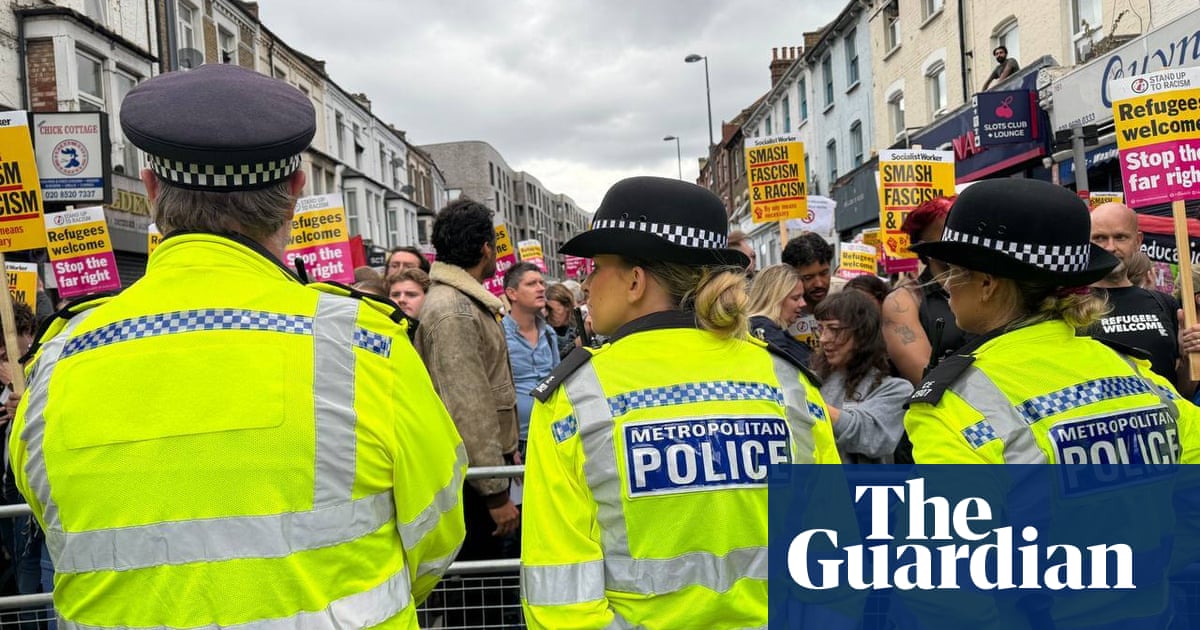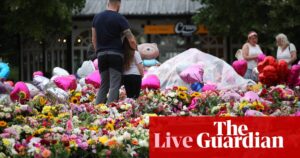
Senior police have described a “turning point” in the disorder seen across England in the past week, suggesting swift sentencing and a major public order operation acted as deterrents to far right-led agitators.
Thousands of anti-racist demonstrators gathered on Wednesday evening and created human shields to protect asylum centres, dwarfing a handful of anti-immigrant rallies.
But in a sign that unrest may continue, 5,000 public order officers will be on duty or on standby this weekend amid evidence of renewed plans by far-right activists to mobilise in cities across England and Wales.
“There are many potential events still being advertised and circulated online and those intent on violence and destruction have not gone away,” said Gavin Stephens, the chair of the National Police Chiefs’ Council (NPCC).
Stephens said would-be troublemakers had been “watching from the fringes” on Wednesday and probably made a judgment in some cases that there were too many officers.
He added: “They’ve certainly been deterred. They’ve certainly received a message from communities. But there’s no complacency at all in our mind that we need to be prepared for the days and particularly the weekend ahead.”
Stephens cited a range of factors for his belief that a “turning point” had been reached after a week of violence following the killing of three girls in the seaside town of Southport on Monday last week.
These included a significant police presence and the deterrent impact of offenders being sentenced in days for their part in the riots, peer pressure from families, friends and work groups, and “the disruption” of some online messaging.
While admitting that he had been “nervous” about the prospect of thousands of counter-demonstrators taking to the streets because it added to “the scale” of what police would have to deal with, Stephens also praised what he described as the stand taken by communities.
The total number of arrests made relating to violent disorder following the Southport killings now stands at 483, according to the NPCC, and 149 charges have been brought.
Senior police officers also insisted that a massive police mobilisation on Wednesday night – the biggest to counter expected unrest since the 2011 riots – was based on firm intelligence from multiple sources, and not just based on a list of immigration lawyer and asylum targets circulated on social media.
“The intelligence was [the] real deal, it looked game on. It was the volume and variety of intelligence that in our force area made it likely there would be trouble, I’d say 55%. Nationally it was stronger. It was quite likely there would be trouble, more like 60% plus,” said one senior officer.
The same source said the first tranche of arrests showed that a lot of people involved in the disorder were low-level criminals and easily influenced.
“You had people crying in court, which tells me they are not a hardcore EDL [English Defence League] member. A lot of people who were violent and have been arrested were the hangers-on rather than core protagonists.”
Another source said it was too early to relax and that the weekend would be key in assessing whether the momentum had been broken. “I suspect the weekend will see the extreme right wing push for larger numbers at fewer locations. It may present an opportunity for us to snuff things out more completely, I hope,” they said.
Hope Not Hate, which investigates the extremist far right, had been sceptical about mass far-right gatherings on Wednesday, saying the list of targets was “aspirational” rather than seriously coordinated.
While far-right activists and supporters had been relatively quiet in recent days, there was evidence of at least eight events being planned for Saturday in cities of various sizes, including Newcastle, Basildon in Essex, Wakefield in West Yorkshire and Yeovil in Somerset.
Others were being planned for Sunday, including in Swansea and Aberystwyth in Wales, while there appear to be plans for a large show of strength in London, close to parliament. Twenty potential gatherings and three counter-protests were also reportedly planned for Thursday.
Stephens also said that at least 104 police officers had sustained injuries since the start of disturbances, including fractures, lesions and severe bruising.
While cases were coming before the courts on a daily basis, Stephens said it was equally important to go after those who were inciting violence online.
“This is a prime example of where this hateful incitement online crossed dramatically over into the real world and made communities feel less safe. And I hope that this is a lesson for all of us that the system needs to change, that behaviour online needs to change, and where the behaviour online is criminal, that there are means of dealing with it,” he said.
Source: theguardian.com

















